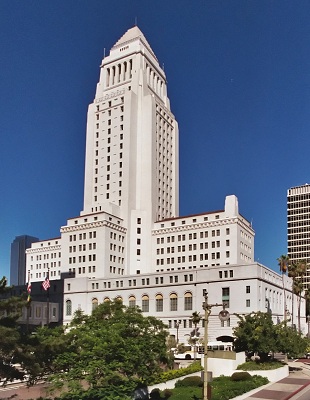LOS ANGELES—The City Administrative Officer released a memo to the City Council detailing its projections regarding the proposed 2014-2015 City Budget on April 15.
The memo to the City Council from Miguel A. Santana was meant to supplement Mayor Eric Garcetti’s proposed budget that seeks to address a projected $242 million shortfall for the upcoming fiscal year and to eliminate it by the 2018-2019 fiscal year.
According to the memo, certain costs that are not included in the budget might hinder efforts in completely eliminating the deficit time for the 2018-2019 fiscal year. One issue that the memo detailed regarded the funding used to cover the cost of overtime banked by Los Angeles Police Officers, who are allowed to bank 800 hours of overtime under the current contract. At the moment, 2.3 million hours worth of overtime at a cost of $192 million have been accumulated; this can be used by officers during time off or in cash payments. The memo stated that in the year before raising the amount of overtime hours for officers caused the department to pay out $92 million in overtime, which far exceeded the $30 million the department’s budget had set.
In addition, the 2014-2015 proposed budget only covered two months of the Fire Department’s ambulance augmentation program, which meant that $8.4 million would still have to be covered following that time. The Mayor’s budget also sought to fund 2,400 lane miles of street repairs in an effort that would improve the quality of streets in the city, but only 2,200 miles worth have been currently covered. The memo further stated that increased expectations from residents to fix more streets would drive further deficits as the special funds used for projects like street repairs would pass the cost over to the General Fund as they lose funding.
One area that could offset some costs would be found in lowering the assumed return investment rate from both the City Employee Retirement and Fire & Police Pension systems by .25 percent; a move which could add another $80 million to the General Fund.
Complicating things would be “city employee-related costs,” which include salaries, pensions and benefits. Despite a 5.1 percent increase in revenue compared to the 2013-2014 budget employee costs have risen by $192 million. The difference between the rises in revenue and costs could further add to the deficit through 2017, where the deficit would grow to $165.2 million for the 2015-2016 fiscal year and $186.8 million for the 2016-2017 fiscal year.
The memo did project that the deficit could begin to decrease by the 2017-2018 fiscal year for a $20.9 million surplus, but in order to do so, the city would have to hold steady in a number of different areas. One factor that could help lower the deficit would be the city’s refusal to reinstate services that were cut during the earlier fiscal crisis, and the only way that these city services could return would be if some offset is found from “new revenues or reductions in other services or costs.” The city’s workforce size would have to remain flat, and increases in the salaries of city workers could not be agreed to in labor negotiations.
Mayor Garcetti unveiled his proposed budget on April 14. Councilman Paul Krekorian introduced a motion on April 23 that would hold a public hearing on the budget on May 20, followed by a special meeting of the City Council to be held on May 21.






